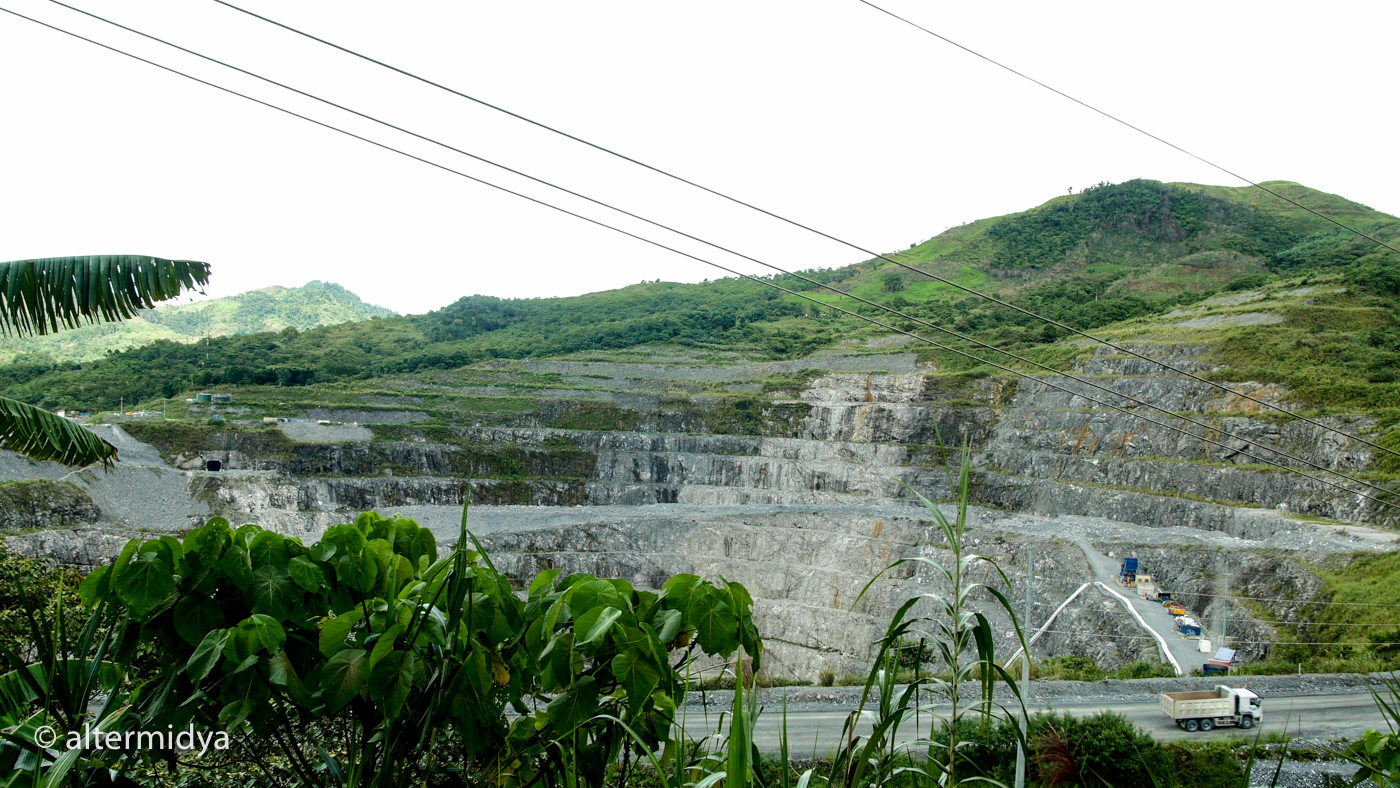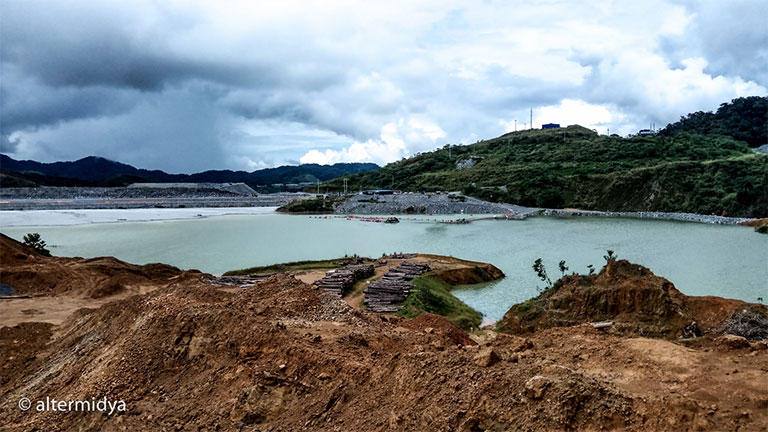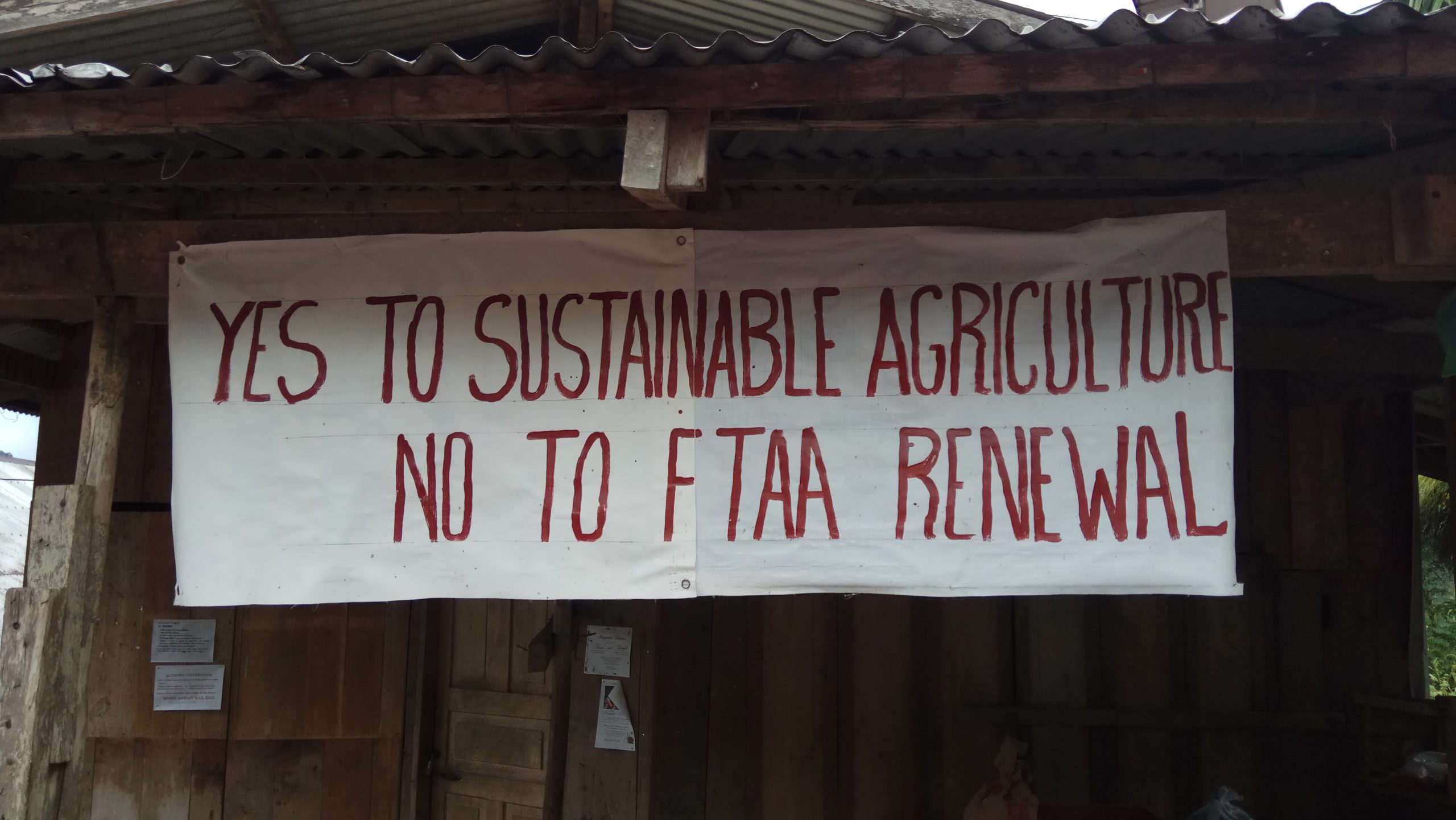Nueva Vizcaya, PHILIPPINES – Since 1 July, indigenous peoples from Kasibu, an upland town in the province of Nueva Vizcaya (some 289 kilometers north of Manila), have barricaded the entrance to the Didipio Mine of the Australian mining firm OceanaGold. Operating one of the country’s largest gold and copper mines, OceanaGold’s contract with the Philippine government – called Foreign and Technical Assistance Agreement (FTAA) – has recently expired. Local villagers, with the provincial government as their ally, are adamant that the mine be immediately shut down.
They allege that OceanaGold is operating illegally without a contract. Hence, residents take turns in guarding the entrance to the mine, barring fuel trucks and trucks loaded with ore from entering and leaving the village of Didipio.
“We put up this barricade because we want OceanaGold out of our lands. They have brought so much destruction to our once peaceful community,” said Julie Simongo, president of the local group Samahang Pangkarapatan ng Katutubong Magsasaka at Manggagawa (Association for the Rights of Indigenous Farmers and Workers).
Indeed, Didipio village looks like a battleground. Banners in front of houses loudly proclaim a stand on OceanaGold—those in favor say that “sustainable mining” has brought “prosperity and development.” Those against it simply say: “Yes to sustainable agriculture, no to mining.”

For advocates opposing the renewal of OceanaGold’s contract, there is nothing sustainable about the mine’s operations. For the past six years, it has contaminated waterways and dried up vital water sources. Crucially situated in a watershed area, it is threatening agriculture, the primary source of livelihood of thousands of farmers not just in the village of Didipio but in the entire Nueva Vizcaya and adjacent provinces of Cagayan Valley, Isabela and Quirino.
Duplicity, discrimination, division
The Didipio mine sits on agricultural lands of indigenous peoples, particularly various tribes of the Ifugao who migrated several decades ago, when “development projects” displaced them from their ancestral lands in the further northern region of the Cordilleras.
The Ifugao say that Climax Arimco Mining Company, the previous owner of the mine, acquired most of their lands through force and duplicity. “We were paid very little. The company also promised to move us to suitable relocation sites, but it never happened,” Simongo said.
Those who lost their lands ended up as mine workers or doing contract jobs for the company. However, not all of the displaced farmers were employed in the mine. In fact, residents say that the company has mainly hired “outsiders” and discriminated against locals. Still, OceanaGold depends on its mine workers for generating local support, often pitting workers against their own tribe. “The biggest effect of mining on our community is that there is now quarreling – families against families, neighbours against neighbours,” rued Lorenzo Pulido, an elderly Ifugao leader.
Through time, resistance to the mine has grown stronger as farmers feel its adverse effects on agriculture. They attribute low yields to the effects of air pollution, river pollution, and water shortage. Pulido, a citrus farmer, said that he used to harvest 15,000 kilos of citrus per season, now it’s down to 4,000 kilos. Rice farmers also can no longer plant rice regularly because sources of irrigation have dried up. “We used to have all the food we need – rice, vegetables, and fruit. Now, we have to buy food from the market,” Pulido said.
Residents also decry the lack of clean water. According to them, toxic mine tailings overflow during heavy rains, and spill into the river. While OceanaGold denies this, a 2016 Multi-Partite Monitoring Team report found relatively high levels of toxic chemicals such as lead, manganese, cadmium, sulfates, iron, and arsenic in several rivers and streams near the mine.

The Didipio mine is right at the headwaters of the Addalam River, a tributary of the Cagayan River and the locus of the Addalam River Irrigation System, which provides irrigation to thousands of farmlands in Isabela, Quirino, and Cagayan Valley. According to a position paper by the Nueva Vizcaya Provincial Government, “Didipio should have been shielded from any extractive economic activity that may impair its viability as a watershed haven supporting vital downstream enterprises.”
“What happens to us?”
The Didipio mine was built by virtue of the first FTAA issued under the Mining Act of 1995. Environmental and land rights advocates have long been calling for the repeal of the said law, which allows for 100% foreign-led mining operations under a 25-year contract with the Philippine government.
After the expiration of the said FTAA last 20 June, the provincial government filed for and was granted a Temporary Restraining Order by a local court against OceanaGold’s operations. However, the company insists that the Mines and Geosciences Bureau, an agency of the country’s environment ministry, has allowed them to continue operating pending a decision by the Office of the President on their FTAA renewal bid.

Former Nueva Vizcaya governor Ruth Padilla, who visited the people’s barricade, appealed to Pres. Rodrigo Duterte to cancel OceanaGold’s contract. She fears that another 25 years of the mine would irreparably destroy local agriculture and ecotourism, and result in landslides such as those that occur in mining areas in Cordillera. “After their operations, what happens to us? Where do we get money for rehabilitation? Will they able to bring back the forests or the mountain they’ve already flattened? Where will the toxic mine tailings go?” Padilla said.
According to a study by the environment ministry, 68% of commercially-operated mines in the country violate various environmental laws. A known environment advocate who used to head the ministry ordered the closure of these mines, but was removed from office before having the chance to implement the order. An ex-military officer took over – an appointment by Pres. Duterte that does not sit well with indigenous peoples who often bear the brunt of human rights violations committed by military personnel deployed to “secure” mining sites.
Seventy-two percent of the total land area devoted to mining, or about 542,245 hectares, are ancestral lands which indigenous peoples rely on for livelihood. Mining proponents say that the industry creates much-needed employment in the countryside. However, mining only accounts for a mere 0.05% of the country’s total workforce while agriculture accounts for 23 percent.
On social media, “troll” accounts that defend OceanaGold claim that the company’s mining operations do not adversely impact agriculture, and that the two can co-exist. But from the accounts of affected farming and indigenous communities, that is clearly not the case.

During a solidarity night at the barricade, an indigenous woman farmer spoke with tears in her eyes: “The past 25 years have gone by like a destructive typhoon. I am happy to see that so many people support us in our struggle. We have been suffering in silence for a long time. Finally, we have a chance to end our suffering.” ###
PAN Asia Pacific joined the National Solidarity Mission to the People’s Barricade against Oceanagold Mining in Nueva Vizcaya from July 26 to August 1, 2019. It was organized by the Kalikasan People’s Network for the Environment (Kalikasan PNE), the Alyansa ng Novo Vizcayano para sa Kalikasan (ANVIK), and the United People’s Organizations of Didipio.

#NoLandNoLife Features discuss recent developments, events, and trends on land and resource grabbing and related human rights issues in the region as well as the factors and forces that drive it. Send us your feedback at nolandnolife@panap.net.








Discussion about this post